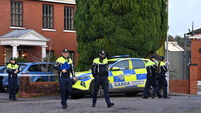Equipment used in paraglider crash in Kerry was old and should not have been used, say investigators

The paraglider, which had been manufactured in Spain in 2000, had been bought online by the pilot in 2019 without a user manual. File picture:
Paraglider equipment involved in a serious incident in the Conor Pass in Kerry last year, in which an individual suffered serious injuries after crashing into cliffs, was old and should not have been in use, an investigation has revealed.
The potentially fatal incident occurred at the Maughanablagher Cliffs, Co Kerry, on March 19, 2024, when the paraglider’s canopy suffered a partial collapse after its pilot jumped off a cliff ledge near the Conor Pass.
The pilot was seriously injured after colliding with rocky terrain and needed to be rescued from the cliff face by the Irish Coast Guard unit in Dingle and transferred by ambulance to a local hospital.
A report by the Air Accident Investigation Unit noted that the manufacturer of the Windtech Ambar 29 Paraglider had informed investigators that it was quite old and should not have been flying.
The paraglider, which had been manufactured in Spain in 2000, had been bought online by the pilot in 2019 without a user manual.
The manufacturer told the AAIU that the fabric of canopies stretches as they age which is difficult to detect and can change their overall shape which could affect their handling characteristics.
The 34-year-old pilot, who had 60 hours of experience on paragliders, described himself as “a competent novice”. The man, who was holidaying in Kerry, reported feeling a lack of tension as he approached the cliff edge and experienced a “steep dive” as he jumped.
A video of the launch recorded by a friend of the pilot showed no observable lift in the paraglider during the run-up to the cliff edge. The friend, who witnessed the paraglider disappearing from view, said it was the most adventurous flight she had observed the pilot undertaking.
A local pilot with experience of paragliding in the area, who was interviewed by the AAIU, said he had travelled to the Conor Pass earlier that day but claimed the weather was quite murky with low cloud and “whiteout” conditions which prevented him from launching.
The local pilot said while the area was regarded as quite safe for paragliding, a flight in a northerly direction as taken by the injured pilot carries a greater risk due to the interaction of any wind with the cliffs.
The canopy collapsed on the right hand side which caused the paraglider to turn towards the cliff face. Although it re-inflated, the AAIU said it was too late for the pilot to regain effective control and he impacted with terrain.
The pilot was dragged down the cliff face following the impact. He was not wearing a helmet as it had been brought home the previous day by a relative. Despite sustaining serious injuries, he was able to use his mobile phone to call the emergency services and request assistance.
The AAIU said the wing collapse was likely due to insufficient lift, lack of tension in the risers and a possible tailwind component.
The AAIU report said it considered it good practice for novice pilots to avail of information on maintenance, insurance, site briefings and mentorship provided from experienced instructors which are provided by paragliding associations.












